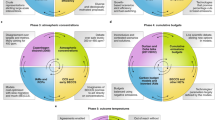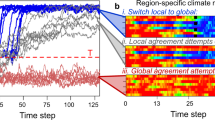A balance of bottom-up and top-down in linking climate policies
Top-down climate negotiations embodied by the Kyoto Protocol have all but stalled, chiefly because of disagreements over targets and objections to financial transfers. To avoid those problems, many have shifted their focus to linkage of bottom-up climate policies such as regional carbon markets. This approach is appealing, but we identify four obstacles to successful linkage: different levels of ambition; competing domestic policy objectives; objections to financial transfers; and the difficulty of close regulatory coordination. Even with a more decentralized approach, overcoming the 'global warming gridlock' of the intergovernmental negotiations will require close international coordination. We demonstrate how a balance of bottom-up and top-down elements can create a path toward an effective global climate architecture.
This is a preview of subscription content, access via your institution
Access options
Subscribe to this journal
Receive 12 print issues and online access
206,07 € per year
only 17,17 € per issue
Buy this article
- Purchase on SpringerLink
- Instant access to full article PDF
Prices may be subject to local taxes which are calculated during checkout
Similar content being viewed by others

The co-evolution of technological promises, modelling, policies and climate change targets
Article 20 April 2020

A well-timed shift from local to global agreements accelerates climate change mitigation
Article Open access 18 May 2021

Determining the credibility of commitments in international climate policy
Article Open access 01 September 2022
References
- Rayner, S. How to eat an elephant: A bottom-up approach to climate policy. Clim. Policy10, 615–621 (2010). ArticleGoogle Scholar
- Falkner, R., Stephan, H. & Vogler, J. International climate policy after Copenhagen: Towards a 'building blocks' approach. Glob. Policy1, 252–262 (2010). ArticleGoogle Scholar
- Victor, D. G. Global Warming Gridlock: Creating More Effective Strategies for Protecting the Planet (Cambridge Univ. Press, 2011). BookGoogle Scholar
- Jaffe, J., Ranson, M. & Stavins, R. N. Linking tradable permit systems: A key element of emerging international climate policy architecture. Ecol. Law Quart.36, 789–808 (2009). Google Scholar
- Jaffe, J. & Stavins, R. N. in Post-Kyoto International Climate Policy: Implementing Architectures for Agreement (eds Aldy, J. E. & Stavins, R. N.) Ch. 4, 119–150 (Cambridge Univ. Press, 2010). Google Scholar
- Metcalf, G. & Weisbach, D. Linking policies when tastes differ: Global climate policy in a heterogeneous world. Rev. Environ. Econ. Pol.6, 110–129 (2012). ArticleGoogle Scholar
- Ranson, M. & Stavins, R. N. Post-Durban climate policy architecture based on linkage of cap-and-trade systems. Chicago J. Int. Law13.2 (2012).
- Stewart, R., Oppenheimer, M. & Rudyk, B. A new strategy for global climate protection. Clim. Change120, 1–12 (2013). ArticleGoogle Scholar
- Olson, M. The Logic of Collective Action: Public Goods and the Theory of Groups (Harvard Univ. Press, 1965). Google Scholar
- Weitzman, M. L. Can negotiating a uniform carbon price help to internalize the global warming externality? J. Assoc. Environ. Resour. Econ.1, 29–49 (2014). Google Scholar
- Wagner, G. & Weitzman, M. L. Climate Shock: the Economic Consequences of a Hotter Planet (Princeton Univ. Press, in the press).
- IPCC Summary for Policymakers in Climate Change 2014: Mitigation of Climate Change (eds Edenhofer, O. et al.) (Cambridge Univ. Press, 2014).
- Nachmany, M. et al. The GLOBE Climate Legislation Study: A Review of Climate Change Legislation in 66 Countries 4th Edn (GLOBE International/Grantham Research Institute, London School of Economics, 2014). Google Scholar
- Mansell, A. (ed.) Greenhouse Gas Market 2012: New Markets, New Mechanisms, New Opportunities (International Emissions Trading Association, 2012). Google Scholar
- Grubb, M. Emissions trading: Cap and trade finds new energy. Nature491, 666–667 (2012). ArticleCASGoogle Scholar
- State and Trends of Carbon Pricing (World Bank, 2014).
- Victor, D. G., House, J. C. & Joy, S. A Madisonian approach to climate policy. Science309, 1820–1821 (2005). ArticleCASGoogle Scholar
- Dellink, R., Jamet, S., Chateau, J. & Duval, R. Towards global carbon pricing: Direct and indirect linking of carbon markets. OECD J. Econ. Studies2013 (2014).
- Ellerman, A. D., Convery, F. J. & De Perthuis, C. Pricing Carbon: The European Union Emissions Trading Scheme (Cambridge Univ. Press, 2010). BookGoogle Scholar
- Victor, D. & House, J. A new currency: Climate change and carbon credits. Harv. Int. Rev.26, 56–59 (2004). Google Scholar
- Milner, H. V. Interests, Institutions, and Information (Princeton Univ. Press, 1997). Google Scholar
- International Carbon Market (European Commission, 2014); http://ec.europa.eu/clima/policies/ets/linking/index_en.htm
- Jervis, R. System Effects (Princeton Univ. Press, 1997). Google Scholar
- Raustiala, K. & Victor, D. G. The regime complex for plant genetic resources. Int. Org.58, 277–309 (2004). ArticleGoogle Scholar
- Burtraw, D., Palmer, K., Munnings, C., Weber, P. & Woerman, M. Linking by Degrees: Incremental Alignment of Cap-And-Trade Markets Discussion Paper 13–04 (Resources for the Future, 2013). Google Scholar
- Sabel, C. F. & Zeitlin, J. Experimentalist Governance in the European Union: Towards a New Architecture (Oxford Univ. Press, 2010). Google Scholar
- Ostrom, E. A polycentric approach for coping with climate change. Ann. Econ. Finance15, 71–108 (2014). Google Scholar
- Pizer, W. A. & Yates, A. J. Terminating Links between Emission Trading Programs Discussion Paper 14–28 (Resources for the Future, 2014). Google Scholar
- Urpelainen, J. A model of dynamic climate governance: dream big, win small. Int. Environ. Agreements Polit. Law Econ.13, 107–125 (2013). ArticleGoogle Scholar
Acknowledgements
For comments and discussions, we thank R. Ahuja, S. Barrett, D. Bodansky, D. Burtraw, F. Convery, D. Dudek, A. Ghosh, T. Hale, A. Hanafi, J. Haverkamp, N. Keohane, R. Keohane, J. Margolis, G. Metcalf, E. Morehouse, M. Oppenheimer, A. Ovodenko, A. Petsonk, B. Rudyk, R. Saines, R. Socolow, R. Stavins, J. Urpelainen, D. Victor, D. Walker, M. Weitzman, M. Zaragoza-Watkins and R. Zeckhauser. We thank K. Rittenhouse for excellent research assistance. T.S. thanks Mistra and Formas for funding.
Author information
Authors and Affiliations
- Department of Political Science, Case Western Reserve University, 10900 Euclid Avenue, Cleveland, 44106, Ohio, USA Jessica F. Green
- University of Gothenburg, Vasagatan 1, Gothenburg, 40530, Sweden Thomas Sterner
- Environmental Defense Fund, 18 Tremont Street, Suite 850, Boston, 02108, Massachusetts, USA Thomas Sterner & Gernot Wagner
- Columbia University School of International and Public Affairs, 420 West 118th Street, New York, 10027, New York, USA Gernot Wagner
- Harvard Kennedy School, 79 John F. Kennedy Street, Cambridge, 02138, Massachusetts, USA Gernot Wagner
- Jessica F. Green




